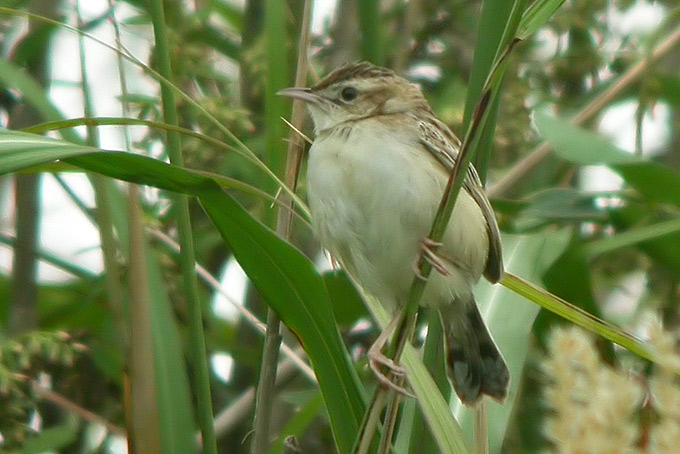 | E-mail to Birds Korea |
 | KWBS |
in the Region
 | The Oriental Bird Club |
 | BirdLife International (Asia) |
October
Warm (typically between 15-20°C mid-month), with often excellent birding weather: dry, sunny, and relatively calm. Occasional rain, although uncomfortable for birdwatchers, can produce excellent falls. One of the best times to be birding in Korea! Autumn migration is in full swing, and anything is possible!
Black-faced Spoonbill and Chinese Egret are still reasonably widespread. Hooded and White-naped Cranes start moving back south into Korea, and huge concentrations of Tundra Beans and Greater White-fronted Geese form at the Han-Imjin and Seosan. The charismatic Baikal Teal arrives in force mid-month, with up to 300,000 at Seosan and Haenam! Raptor migration is often strong, with Grey-faced Buzzards (day peak of 1,500 on Gageo Island), Oriental Honey Buzzards, the occasional eagle (especially Greater Spotted), and in some years, flocks of Amur Falcon. Shorebirds are still present in good numbers and persity, with a peak in Nordmann’s Greenshank. Visible migration peaks with Olive-backed Pipits becoming numerous by mid-month along the west coast, plus often excellent numbers of buntings and flycatchers. Pale, White’s, and small numbers of Dusky Thrushes are also on the move, along with the first of the typical winter passerines - Brambling and Siskin.
In 2005 the country’s first Swinhoe’s Rail in 70 years was reported from Hong Island, while recent Korean firsts for this month include Yellow-bellied Tit on Socheong in 2005 and Booted Eagle on Heuksan Island in 2006.
(The following records are a compilation of our own sightings and records sent in by other observers. As well as being posted on the Birds Korea website(s), selected records are also forwarded to other Korean-language birding websites; records of threatened species are arranged and forwarded to Birdlife International and national authorities when appropriate; flag images and records are passed to bodies responsible for their coordination throughout the flyway; and all records sent to us are used to compile annual reports and to support the evolving understanding of the status of many of Korea’s birds.)
Hadori-Jeju, October 28
We managed to get in a day's birding Hado-ri migratory bird habitat. The weather was slightly overcast and from a distance, the lake-pond areas looked bleak. Upon closer observation, avian activity demanded constant attention. Highlights were as follows: 1 Common Kingfisher, 12 Black-faced Spoonbill, 3 Eurasian Skylark, 12 Grey Heron, 1 Daurian Redstart, 3 Osprey, good numbers of Eastern Spot-billed Duck, Common Teal, Mallard, Eurasian Wigeon, Tufted Duck, & Northern Pintail; 3 Northern Lapwing, 24 Common Pochard, 1 Common Snipe, 1 Northern Goshawk, 68 Coot, 5 Little Grebe 60 Great Cormorrant and 2 Greater Scaup.




Socheong Island, October 25-28
October 28:With greatly increased visibility a few more birds on the move, with most notable including over 100 Dusky Thrush moving west, with a further 50 “blogging” back and forth over the main ridge. These thrush flocks contained at least one Naumann’s and two Red-throated Thrush – one an adult male, the other a First-winter. Also on the move were the personal first Hawfinch and Short-eared Owl of the autumn, the latter (after repeated mobbing by two of the local Peregrine, followed by prolonged talon grasping) dropped into the sea, to then be swooped on by one of the Peregrine, and mobbed by a flock of 50 Black-tailed Gull. After sitting on the sea for 15 minutes, the owl tried to get airborne, but failed, and apparently drowned. Also off North Point, nine Mandarin Duck and a Little Grebe, the last perhaps a new species for Socheong?
October 27: With Marc van Roomen until midday, a North Point watch in very hazy conditions (with visibility of only between 10-12 km). Highlight of the day was the Asian Short-toed Lark (present since October 16th at least) which finally showed well, feeding on the track with the Far Eastern Lark.


October 26: With Marc van Roomen. With poor visibility due to a mixture of early fog and yellow dust, very few birds on the move. Best for the day was a Yellow-streaked Warbler (fourth national record and the fourth record for Socheong!) very poorly digiscoped in lighthouse gully. While the bird did not call, identification (in direct comparison with several Dusky Warbler) was based e.g. on its striking broad and white-looking supercilium (only very faintly browner to the fore), its eyestripe (black before the eye, brown and diffuse behind it), its dull underparts (with some obvious streaking across the breast), contrasting with its much warmer rust-toned vent, and its strong tarsi (looking clean pink in the field, without the brighter toes of Raddes’). Its behaviour, clambering in the tops of small trees, also appeared rather untypical of either Dusky or Raddes’ Warblers). Rather more intriguing was the medium-sized owl seen again, again hunting like a Tyto in the main village at 0520 and again at 2030. An almost two hour watch failed to re-find it.

October 25: With Shim Kyu-sik in the morning and Marc van Roomen of SOVON from midday. Sadly no sign of the Great Grey Shrike, though the Asian Short-toed Lark remains (apparently one of four in the ROK this month, with two on Hong and one on Heuksan Islands on about October 22), now joined by a Far Eastern Lark, with a Pine Bunting and a poorly seen medium-sized owl sp. hunting in the main village at 0520 the other highlights.
Buk Gil-ri, Muan county, October 25
Along with c. 100 Eastern Spot-billed Duck. c. 40 Common Teal and some Northern Shoveler, Common Teal and Common Moorhen 12 Swan Goose were seen.

Seosan, October 25
With the recent cool weather, thousands of geese have flocked to Seosan: a rough guess is that we saw well over 100 thousand Bean and White-fronted Geese. Among these, one Lesser White-fronted Goose (heard only) and small numbers of waterfowl: Common Teal, Spot-billed Ducks, Wigeon and Ruddy Shelducks. Other highlights were: Chinese Penduline Tits and Pallas’s Reed Buntings (also heard only), about 20 Far-Eastern Larks, 45 Eurasian Spoonbills, 1 Greater-spotted Eagle, a Eurasian Bittern, a Western Osprey and an Amur Leopard Cat. We also found a dead Raccoon Dog, probably hit by a car.





Songdo, October 25
Generally little of note in a brief 2 hours look, although e.g 28 Ruddy Shelduck and 2 Wigeon (rare for this site) on the lagoon. At the golf course, 2 skulking Tristram's Bunting, 2 Pale Thrush, 2 Brambling, c.30 Yellow-throated Bunting and a cruising Eurasian Sparrowhawk.
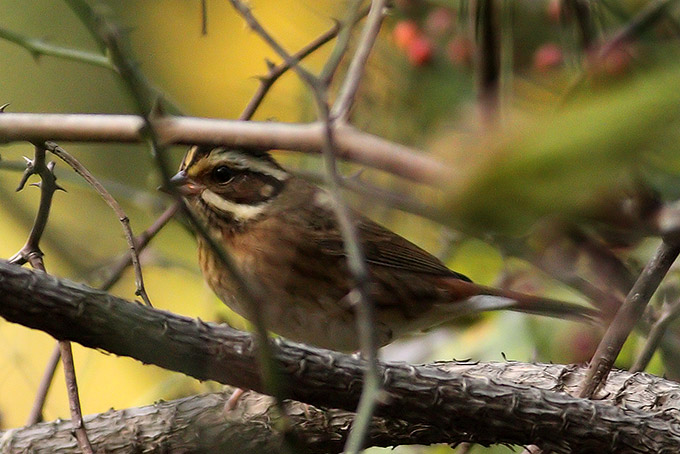

Socheong Island, October 19-24
With extremely limited internet access, exceptional records only
October 23: Ten Great Knot west early in the morning after a stunning sunrise were the first for Socheong, eclipsed by a juvenile Great Grey Shrike (tentatively ascribed to the subspecies sibiricus). Also, the Asian Short-toed Lark still remains.

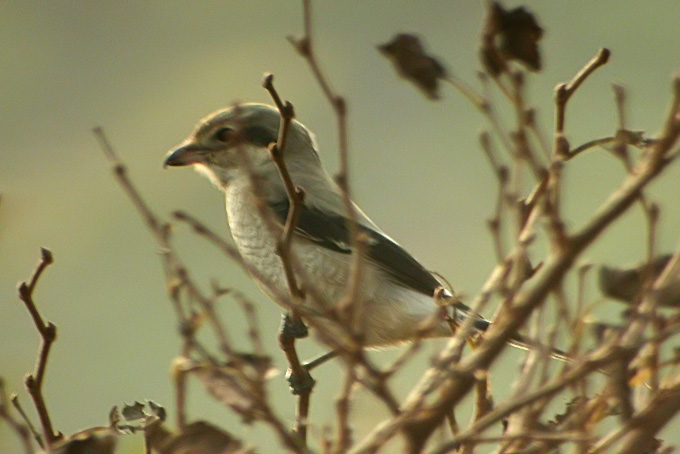
October 23: Two Taiga Bean Goose and another (or the same?) Saker Falcon were the obvious highlights of the “viz-migging”. The Asian Short-toed Lark remains, and still extremely elusive, while a flock of 2,320 Black-legged Kittiwake off the southeast of the island during the seabird count was highly noteworthy.
October 22: Now three Light-vented Bulbul present at Fish-farm, while the Asian Short-toed Lark remains.

October 21: A wonderful day! Starting a little slow, movement increased through the day despite (or because of?) the wind, and highlights included a close encounter with a Japanese Quail and at least 2400 Eastern Great Tit counted moving northwest from North Point between 0630 and about 3pm. Also on the move were several raptors, including a presumed Eastern Marsh Harrier, and rather more exceptional, Socheong’s first Saker Falcon! Best for the day was still to come though - shortly after midday, with flocks of tits passing overhead in the foreground three distant crows were seen chasing and tumbling. The first two were a local pair of Large-billed Crow: the third was massively larger - a Northern Raven! There are apparently only three published records of Northern Raven in Korea, all from the northernmost province in DPRK. Very poor and distant record shots were attempted (rather unsuccessfully) as the three birds continued to chase and squabble back northward out to sea.

October 20: Again, much of the day spent “viz-migging” (counting visible and audible migrants, in this case departing Socheong from North Point), with highlights yesterday’s Chinese Grey Shrike still, a Hume’s Leaf Warbler, a Ochre-rumped Bunting and the Asian Short-toed Lark still. Low point was a Kestrel-like small falcon, with whitish underwings, a fairly blunt hand and very obviously protruding central tail feathers, all suggesting Lesser Kestrel, seen heading out to sea.

October 19: In very strong northwesterlies, highlights of the SE survey circuit were a briefly seen juvenile Yellow-bellied Tit and a rather more confiding Red-breasted Flycatcher (the latter digi-scoped and sound-recorded).
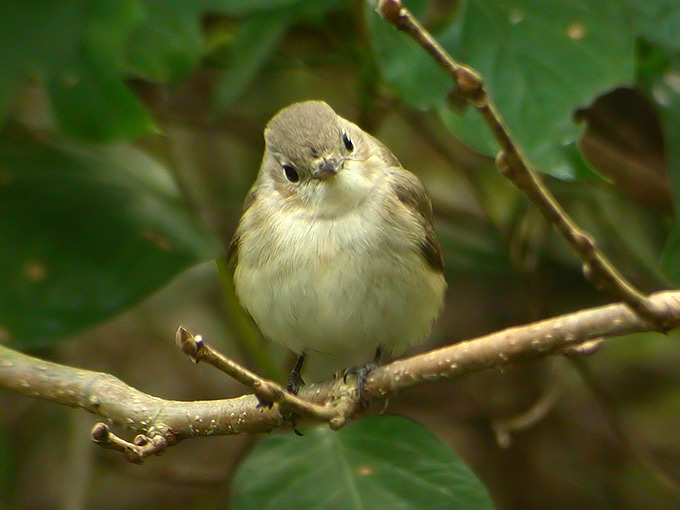
Heuksan island & Gageo island, October 16-21
Oct.16. A morning only at Heuksan-do yielded 1 Chinese Pond Heron, 12 Grey-faced Buzzards, 1 Crested Honey Buzzard, a Common Snipe, a few each of Buff-bellied and Olive-backed Pipits, 2 or 3 calling Pale Thrushes, similar tallies of Chestnut Buntings and Yellow-throated Buntings, 1 Bull-headed Shrike, and the long-staying pair of Long-tailed Shrikes.
The ferry across to Gageo (over calm waters and good visibility) was relatively birdless until after Manje-do, when Streaked Shearwaters suddenly appeared in large numbers: a conservative 1000, with one distant flock of probably more than 500 birds sitting on the water.
On Gageo in the early afternoon, I made the mistake of taking a post-boat and room-settling walk without my camera; at the quarry I encountered the highlight of the trip, a 1st-year Güldenstädt’s /White-winged Redstart perched in very good light 15 metres away on a fencepost along the rocky middle path. A quick description of this strikingly beautiful bird: large size (very conservatively a fifth larger than a Daurian) and robust build were immediately apparent, as was deep red color, entirely dark upperparts, and distinct white “skullcap” (as opposed to the “wig” or “helmet” seen on Daurians), and very extensive white patch on the wing. Closer inspection of the white cap showed areas of pale grey streaking the white. The black color (no brown tones noted) extended well down the breast (far more than I’ve ever seen on a Daurian) and (on a brief view when the bird turned) also extended fully around the back of the nape, preserving the skullcap impression. A very brief and non-ideal flight view (it swooped straight toward me then out of sight) again showed broad and long white on the wing, appearing to extend up into the primaries. Tail pattern was not seen.
I hurried back to the minbak for my camera but never re-found the bird despite two days of specific searching.
Other birds in the same area on the 16th were a slightly surprising Siberian Accentor, 4 Siberian Stonechats, 2 Bull-headed Shrikes, 1 Blyth’s, 4 Richard’s, 5 Olive-backed and 10 Buff-bellied Pipits, 10 Far-Eastern Skylarks, 3 Yellow-browed Warblers, 2 Arctic Warblers, 2 Dusky Warblers, 1 Japanese Quail, 1 Common Snipe, 2 Daurian Redstarts, 3 Yellow-throated, 4 Black-faced, 7 Little Buntings; a Mandarin Duck, 12 White and 3 Yellow Wagtails, 1 Crested Honey Buzzard, 2 Common Buzzard, 1 Eurasian and 1 Eurasian Sparrowhawk.
The 17th added several Chestnut Buntings to the bunting mix; also some unseen Japanese Whiteyes, a Goshawk, a Black Kite, a Schrenck’s Bittern, 3 Pallas’ Reed Buntings, 8 Asian House Martins, 5 Oriental Greenfinches and a different Japanese Quail. Forecast rain did not show up.
On the 18th I took the long and windy trek to 2-gu. Highlights were slightly increased tallies of Yellow-browed (8) and Dusky (4) Warblers, a Western Osprey hauling a large fish over the Gap, a Hoopoe, a White-cheeked Starling, 2 Chinese Penduline Tits, an Amur Falcon very messily devouring a Praying Mantis, an Ochre-rumped Bunting and a Red-throated Pipit. 50 or more Red-rumped Swallows gathered near the trash tip in the evening.
The 19th (very heavy winds, finally moderating in the evening) finally yielded some flycatchers: a Taiga (heard in the morning, seen in the afternoon), an Asian Brown, and a Mugimaki. In the same area I also heard a very brief snatch of a probable Red-throated Thrush. A Yellow-browed Bunting showed at the stream. Highlight was a good view of a Band-bellied Crake. Small numbers of raptors as in previous days; a lone Amur was the highlight.
The 20th, with again a disappointing non-show by expected rain, was less windy (but still no boat!). Some slight increase in buntings: 8 Chestnut, 12 Little, 2 Tristram’s, 5 Pallas’ Reed, 1 Common Reed, 2 Ochre-rumped, 10 Yellow-throated, 2 Yellow-browed, 12 Black-faced, 2 Yellow-breasted and 1 Chestnut-eared Bunting. The trees above the village held calling Great Tits, 2 Goldcrests and a Red-flanked Bluetail. The Buff-bellied Pipit flock seemed to have increased to about 20; the Far-Eastern Larks to 11.
The 21st before the boat had a Black Kite over the harbor but no obvious increase in bird numbers; the quarry bushes were quiet except for a handful of Pallas’ Reed Buntings, some Siberian Stonechats, and the Bull-headed Shrikes.
The return ferry, however, over moderately high waves and hazy conditions, was productive: 1 South Polar Skua, 5 Pomarine Skuas, 2 (quite late: a pleasant surprise) Swinhoe’s Storm Petrels, only 11 Streaked Shearwaters and about 6 thousand Black-tailed Gulls.





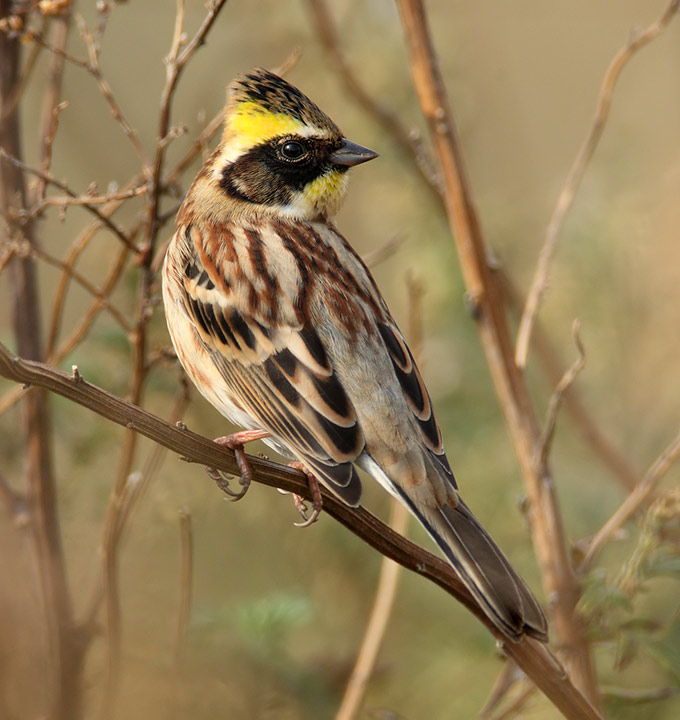


Mokpo Namhang Urban Wetland, October 21
The visit to the site in the sunny afternoon showed the natural tidal area with very high tide and only ca. 50 Eurasian Widgeon accompanied for some time by 2 Little Grebe and c. 30 Black-tailed Gull on the Water. On two platforms 14 Mallard, 11 Grey Heron and 4 Great Cormorants rested in the sun. In contrary the wall enclosed lagoon was a quite busy area: c. 800 Common Teal, c. 180 Dunlin and c. 60 Common Greenshank and 4 Common Sandpiper were bustling around feeding, while the Spot-billed Duck c. 30 and a few Grey Heron were roosting. In one corner 11 Long-billed Plover were very good camouflaged hiding in the rocks. Of special notice a single Olive-backed-Pipit. The reed bed area has another 45 Common Teal, c. 20 Spot-billed Duck and 7 Northern Shoveler and as a surprise 47 Black-crowned Night Heron in the open area on poles and standing in the water.

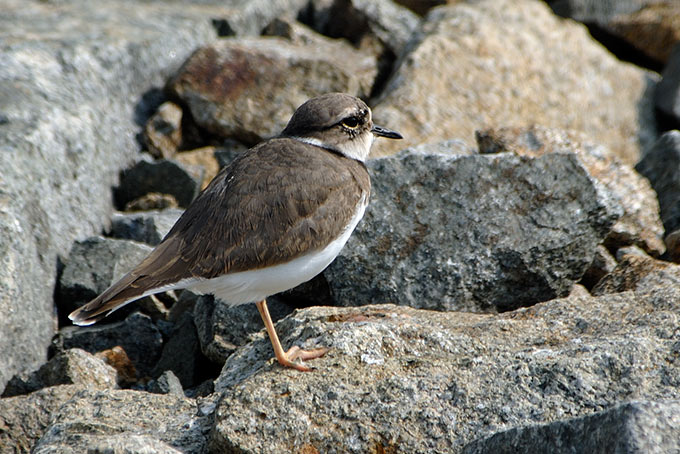




Cheorwon, October 18
In only an hours birding we counted 93 White-naped Cranes, including one group of 77.
Socheong Island, Selected Highlights, October 16-18
With rain on 14th, a storm front (with gale-force winds and a thunderstorm) passing through early on 17th, and another storm front passing through during the night of the 18th, clearly very unsettled weather, with difficult conditions for counting migrants. Numbers of commoner migrants remain low, with most numerous including Yellow-browed Warbler (100 on 17th). Species of most note include three South Polar Skua from the ferry (16th), an Asian Short-toed Lark at North Point (16th-18th) [a species with perhaps only three records nationwide in the past decade], a Hume’s Leaf Warbler (17th), and a Greater Spotted Eagle (18th). On 18th too perhaps the beginning of a major movement of Eastern Great Tit, with >100 moving out to sea in one hour at dawn, and a further 250 logged in the west of the island.
Seogwipo, Jeju island, October 15
Bird activity is picking up in a riverside park, as the October weather continues to be hot and sunny. The usual half dozen Spot-billed Ducks have been joined by 3 dozen more Spot-billed, and about 20 Mandarin Ducks (mostly males). What originally appeared to be two Asian Brown Flycatchers fighting turned out to be an Asian Brown Flycatcher and a female Taiga Flycatcher interacting. The tail-cocking Taiga Flycatcher was quite confiding, affording me long looks.


Mokpo Namhang Urban Wetland, October 14
The morning visit at high tide showed that more than 80% of all birds stayed in the wall enclosed lagoon beside the natural tidal-flat. In the site: c. 100 Black-tailed Gull, 18 Black-headed Gull, 560 Common Teal, 50+ Eastern Spot-billed Duck, 44 Eurasian Wigeon, 25 Mallard, 74 Grey Heron, 13 Little Egret, c. 120 Dunlin, c. 70 Common Greenshank, 11 Long-billed Plover, several Common Sandpiper and 2 Green-Sandpiper. 14 Black-crowned Night Heron hiding the reed bed while 20+ White Wagtail of subspecies leucopsis, ocularis and lugens where seen at all locations of the side. In one lagoon a single Little Grebe tried to stay away from any disturbance.
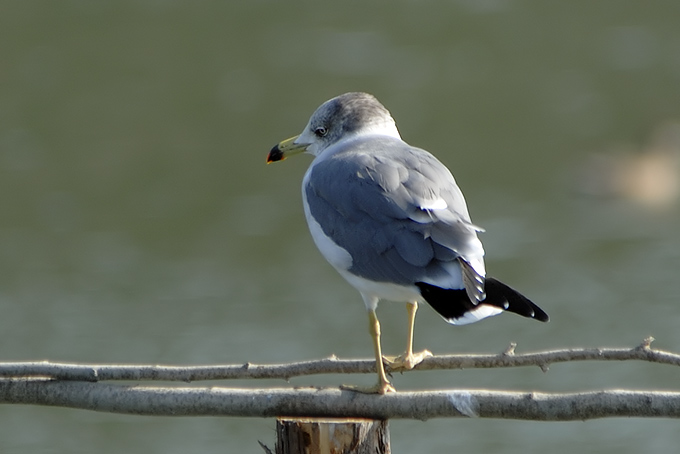


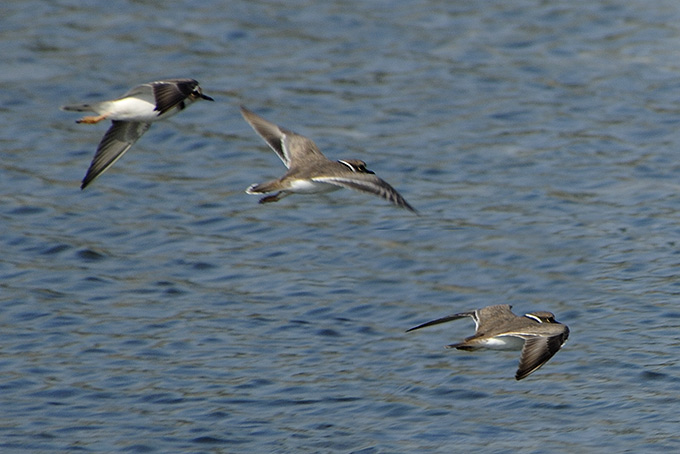
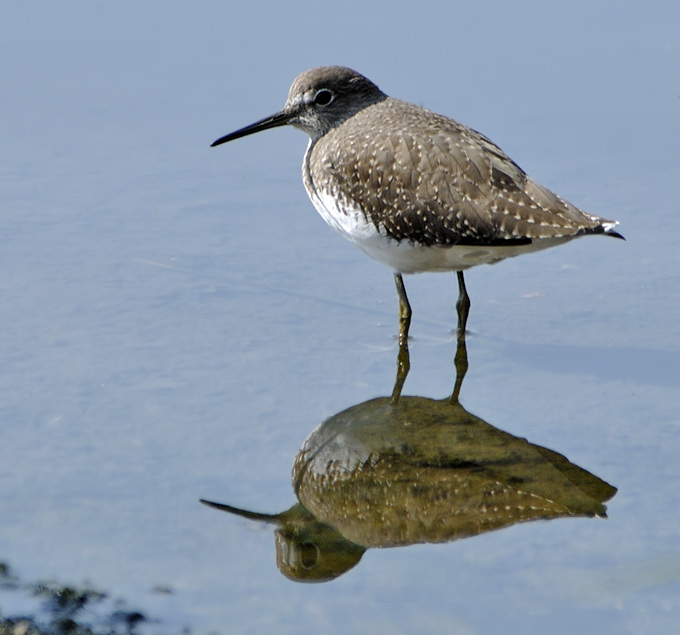

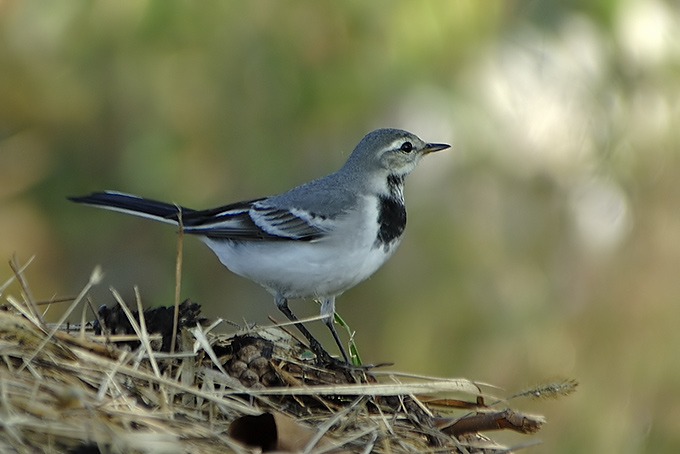

Uiwang, October 12
Of 30+ species at this inland reservoir, most interesting a loose post-breeding group of 13 Long-billed Plover (all seen very well through scope and showing the diagnostic features). The reeds were crawling with abundant Black-faced Bunting- easily 250 present in just a half-circuit of the lake. Also of interest 3 Red-necked Stint, 2 Dunlin, 1 Temminck’s Stint & 4 Great Cormorant which are uncommon inland, an early flock of 15 Brambling, 1 Northern Goshawk, 12 Mandarin (mostly moulted into winter plumage), 1 Baikal Teal, several Common Snipe (showing much individual variation) and the resident Common Kingfisher. Mr. Kwak reports a recent Siberian Rubythroat here, which is likewise scarce on the mainland.




Socheong-do, October 9-11
October 9: The morning Incheon-Socheong ferry ride (cool, cloudy with occasional sun, moderate waves) was practically birdless (a couple of Streaked Shearwaters and a Hobby hawking a dragonfly over the waves) up to about 30 minutes out from Socheong and a sudden patch of activity: from one side of the boat only (due to crowded deck and also light conditions) a conservative 50 Pomarine Skuas, 2 or 3 Parasitic Skuas, 80 Streaked Shearwaters and 3 Flesh-footed Shearwaters.
On the island, locals confirmed that a very small passage of rain (less than 5 minutes) had come through in the morning; not surprisingly, bird numbers appeared relatively low, with only the very vocal Yellow-browed Warblers (about 30 for the day) in more than single digits; with these a couple of Pallas’ Warblers (heard), a few Arctic Warblers, two Bramblings, one or two Olive-backed Pipits and one Buff-bellied Pipit (all heard only), 6 Black-faced Buntings and one each of Rustic, Yellow-throated and Little Buntings, several Grey-backed Thrushes and one Dusky Thrush, one Red-flanked Bluetail, one Greater Spotted Woodpecker, one Asian Brown Flycatcher, one Chinese Bulbul, several Siberian Stonechats, a single Rubythroat and two Daurian Redstarts. Raptors overhead were not at all numerous: a Hobby, a Peregrine, a Eurasian Sparrowhawk, a Japanese Sparrowhawk, 2 Black Kites, a single Honey Buzzard, 2 Kestrels and 3 Common Buzzards.
Highlight (or lowlight) was an all-too brief look at a probable Band-bellied Crake flushed at close range from a weedy path.
October 10: Winds apparently still from the Northeast: a relative paucity of birds. Highlights were an unseen flock of Chestnut-flanked Whiteyes, a few more Bramblings, 2 Meadow Buntings, numbers of Pipits and Yellow-browed Warblers similar to the previous day’s, 2 Common Rosefinches, a Goshawk , a Hawfinch and a poor glimpse of an apparent Hen Harrier.
October 11: the return ferry yielded somewhat smaller numbers, about 30, of Pomarine Skuas (no Parasitics): juveniles, non-breeding and one striking full-spooned adult. Streaked Shearwater tallied c. 120; with these were 2 Flesh-footed Shearwaters.


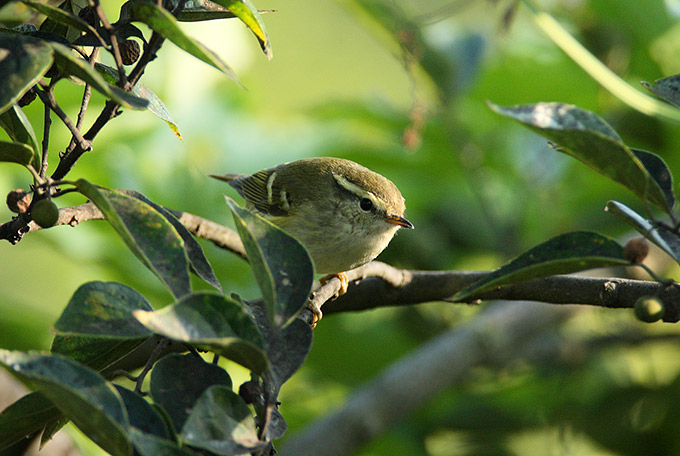

Namhae and Seosan, October 11
Namhae held very little of interest except high numbers of Azure-winged Magpie. The Finless Porpoise were in their usual spot, while Little Egret fished in the shallows of a small stream.
At Seosan, the first bird was a Greater Spotted Eagle which proved to be the only species of special note. There were however reasonable numbers of White-fronted and Bean Goose, Baikal Teal, Tree Sparrow and Azure-winged Magpie. Spotlighting in the evening, we found 2 Amur Leopard Cats, one of which allowed very close views as it stalked a Japanese Quail. Also, several views of Raccoon Dog.

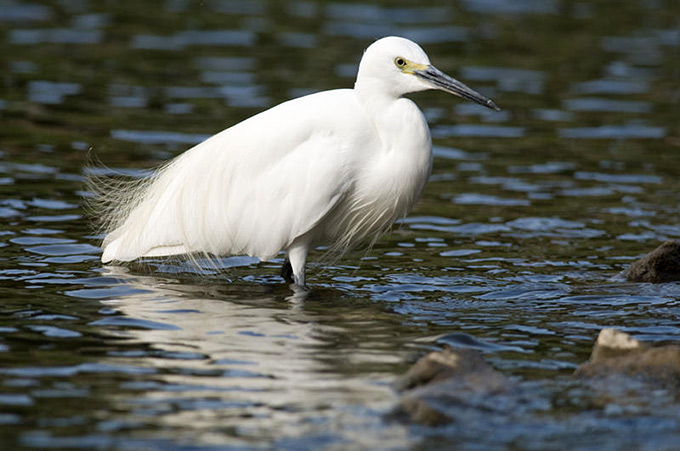


Yeongjong Do, October 11
It was a rather quiet day on the island UNTIL a very large mass of fishermen, grandmothers, and daytime campers congergated upon almost ever section of visible water source (leaving behind a ton of trash too). Black-tailed Gull & Mongolian Gull were the only notable avian variety to out-number the humans. Along the beachfronts I was curiously followed by a small group of 12 Grey-capped Greenfinch. On the salt pans, I noticed 14 Common Teal, 2 Gadwall (f), 10 Common Sandpiper, 6 Marsh Sandpiper and 2 Red Knot. Along the reeds I found 2 playful Grey Wagtail. In a small beach cove, filled with a lot of trash, I found a inquisitive Great Tit & several Large Billed Crow.




Dokjeok, October 10
Sadly much recent concreting on this small inshore island has surgically removed patches of formerly valuable habitat. Best of 31 species in 5 hours was a closely -flushed Japanese Quail, 2 skulking Lanceolated Warbler, a Chestnut Bunting and passing Northern Goshawk (which was dive-bombed by the local territorial Eurasian Hobby). Also, under a bespattered regular perching branch were several seemingly moulted tail and undertail feathers of a Brown Hawk Owl.
Most plentiful were Black-faced Bunting (c.50), Olive-backed Pipit (25) and Yellow-browed Warbler (c.10). Otherwise very quiet and virtually devoid of migrants, with only e.g. 1 Brambling, 2 apparent Far Eastern Lark, 1 Eastern Yellow Wagtail, a Korean Bush Warbler, 1 Grey-backed Thrush, 2 Barn Swallow and 2 Siberian Stonechat.

Gageo Island, October 7 and 8
With continuing north-easterlies (at times gusting to Force 5 in 1-Gu, and much stronger along the island's eastern flank) rather fewer species of note. Highlights on the 7th included another 650 or so Grey-faced Buzzard, and in the evening at least 2,500 Streaked Shearwater, gathered in a feeding frenzy around a cluster of eight fishing boats. Attracted to the mass of birds were one Flesh-footed Shearwater (perhaps the first from the island itself) and three Pomarine Skua. On 8th, slightly less windy, and a similar number of Grey-faced Buzzard through, with one flock of 390 coming in in the afternoon the largest of the day. Other species of note included two Wryneck (the fifth and six of the month so far), nine Mandarin Duck, a flock of 10 Brambling (hopefully, the first flock of many!), three Buff-bellied Pipit and the first Yellow-throated Bunting (3) of Gageo's autumn.

Gageo Island, October 6
Up before dawn to catch any early departing Grey-faced Buzzard that roosted overnight produced a tremendously concentrated departure of at least 1900 birds, with most heading up and then west in just ten minutes. While the 1-Gu circuit produced a decent spread of species (with e.g. over a dozen Siberian Rubythroat, 20+ Red-throated Pipit, and Gageo’s first Little Grebe, Eurasian Wigeon and Dark-sided Flycatcher of the autumn), it was again Grey-faced Buzzard that made the afternoon memorable, with approximately a further 1760 arriving and departing, mostly between 1250 and 1540, giving a (presumably) record-breaking day total of over 3600 “through” Gageo.
Mokpo Namhang Urban Wetland, October 6
The infilling of one wall enclosed lagoon continued …
Today’s monitoring re-found a Black-faced Spoonbill; seen before on October 3rd and 4th, the first record of this globally endangered species for this site. The number of Common Teal increased to c. 250, all residing in the infill area along with 30 Eastern Spot-billed Duck, 17 Eurasion Wigeon, 34 Common Greenshank, 4 Common Sandpiper and a few Grey Heron and Eastern Great Egret. Of special notice a flock of 53 Red-necked Stint, 23 Pacific Golden Plover, 3 Far Eastern Curlew, 2 Bar-tailed Godwit, 1 Common Redshank, 8 Common Moorhen and 6 Grey Wagtail.


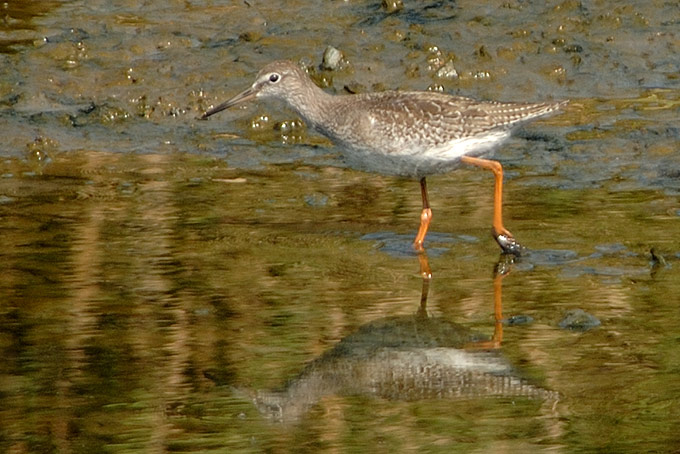

Gageo Island, October 5
In warm sunshine, with winds between SW and SE, another interesting day. 55 or so species logged in 6 hours fieldwork in 1-Gu, including the personal first Eastern Buzzard of the autumn and another Northern House Martin. Best for the day included the one or more probably the two "pure" Red-backed Shrike still feeding within metres of each other, with both now sticking to an area being cleared of wild vegetation as part of regular maintenance work. After some explanation of the rarity and the needs of the shrikes, a very positive decision was then taken to leave the best patch alone until the shrikes have migrated: thank you Gageo Do! Further highlights included another newly-arrived 1200+ Grey-faced Buzzard in the air together in the afternoon, with one pre-roost kettle of 250 also containing an adult Black Stork!
Gageo Island, October 4
A long day in three parts with 70 species logged… The early morning, with gentle SW winds, was part-overcast and part-sunny; midday saw a ferocious storm blow in, with skies blackening, winds abruptly gusting to NE 7 or 8, followed by just ten minutes of rain; and the afternoon, which was largely overcast, humid, and increasingly warm and windless. Before sunrise, first highlight was the sight of 1200 or 1300 Grey-faced Buzzard circling the harbor, to head southwest towards China, while the morning circuit found the Red-backed Shrike (or shrikes) still present, along with small numbers of Chestnut (8), Black-faced (5) and Yellow-breasted Buntings (4), as well as the personal first Chestnut-eared Bunting of the autumn. During the storm, a late Black-naped Oriole and small numbers of returning raptor were over the harbor, including the first of five Amur Falcon logged during the day. Next up, the long hike to 2-Gu where rather few birds. Most numerous there included. White-cheeked Starling (12), joined by a single Chestnut-cheeked Starling and Richard's (7) and Olive-backed Pipits (20). However, scanning the sea from the very top (westernmost) ridge in the late evening, a small sandy-brown chat-like passerine briefly landed close by on a rock outcrop... Digi-binned quickly, the immediate and excited id was that this was a Desert Wheatear: Korea's third record (and a personal first since one in northern Scotland over 25 years ago!). Even as the bird moved further away along the cliff face, the id started to feel a little less certain: do Desert Wheatear show a dark loral line? Thanks therefore to Charlie Moores and Paul Leader for both kindly and independently (re-)confirming the id from the image. The two previous Korean records are of one in Pohang on the East coast on January 26th 2008, and another (well-twitched!) on Eocheong Island from May 2nd-5th 2009.
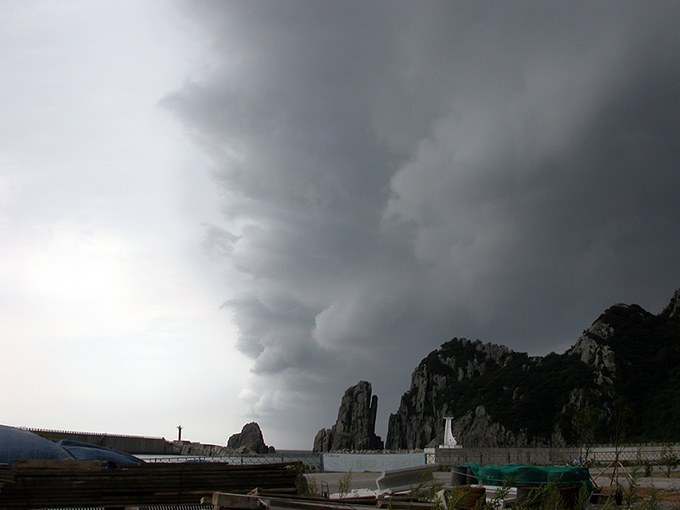

Mokpo Namhang Urban Wetland, October 5
A short visit in the early morning revealed that more damage with infilling had been done to the site.
The number of Great Eastern Egret had dropped to about 20, only a few Little Egret had been seen, but ca. 50 Grey Heron were all over the place. Ducks are now the majority at the site, c. 150 Common Teal, c. 60 Eurasian Wigeon and Eastern Spot-billed Duck each. In the reedbed area also 3 Northern Shoveler along with a juvenile Moorhen appeared briefly from the reed. Shorebirds seen were c. 40 Common Greenshank (also at all locations of the site), several Common Sandpiper, one Long-billed Plover and surprisingly in a corner of one wall enclosed lagoon 21 Pacific Golden Plover. Other species worth a notice are: a Grey-heade Woodpecker, c. 10 Barnswallow circling over the reed, 11 Oriental Turtle Dove on a lawn, 2 Grey and 9 White Wagtail.

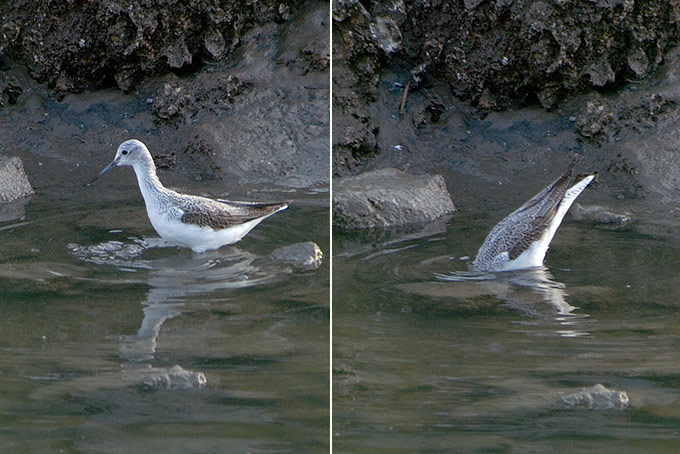

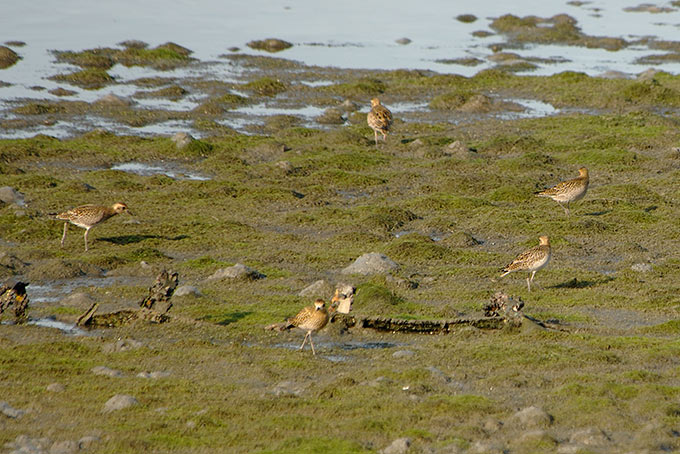



Paldang, October 4
It turned out to be a wonderful fall day on a stroll from Paldang to Deokso. I encountered the following notables: 3 Little Grebe, 6 Daurian Redstart, 1 Osprey, 3 Common Merganser (f), 12 Common Pochard, 6, Common Teal, 12 Mallard, 15 Black-faced Bunting, 32 Great Cormorrant, 3 Tree Pipit, and small numbers of Little Egret, Eastern Great Egret, and Grey Heron.



Socheong, October 3
The spectacular movement of migrants continued unabated. A vantage point on the northern peak provides a heavenly view of the island and silver sea, with a clear but distant look at the north Korean coast. From here raptors can be picked out floating in off the sea, before forming loose kettles and cruising along the ridge, lastly spiralling upward with ground-assisted thermals before arcing down to commence a long straight glide toward China's Shandong peninsula.
From 9am-12.30am another 39 Crested Honey Buzzard were logged, 2 Amur Falcon, perhaps 25 Eurasian Sparrowhawk, similar numbers of Japanese Sparrowhawk & Northern Goshawk, 2 Grey-faced Buzzard, 2 Black Kite (one apparently peppered with gunshot holes through its tail),1 Western Osprey, 4 distant unidentified thrushes and Larks, and 10 Brambling. Barn Swallow seem to have completely replaced the Red-rumped of the previous day- with upwards of 250 counted. Most intriguing was an unusually pale Northern Hobby, quite unlike any I have seen previously: it stood out from the c. 20 others of the morning.
New faces consisted of 1 Rufous-tailed Robin, 2 Oriental Greenfinch,1 Grey Wagtail, a Bull-headed Shrike, 2 Jay, 5 Chestnut Bunting, 2 Ashy Minivet, a Blue Rock Thrush, and a Red-throated Flycatcher: also another Lanceolated Warbler.
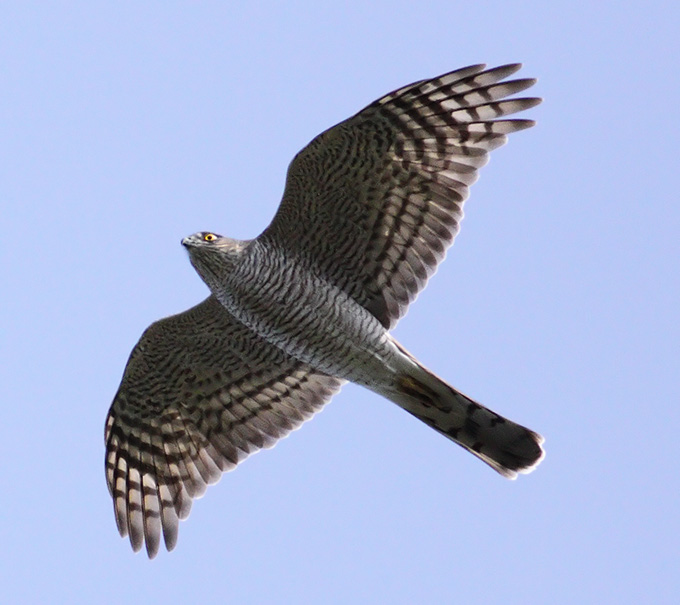


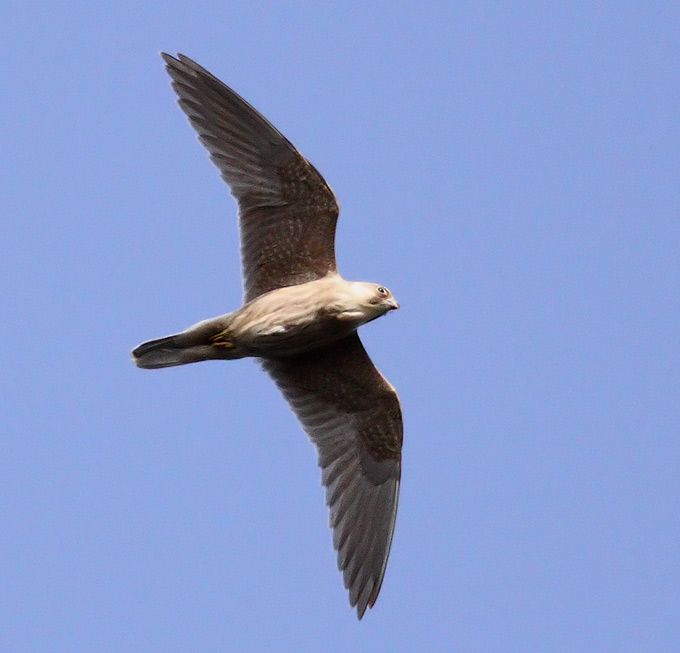

Okksu, October 3
It was a fairly pleasant fall day down the stream. There is quite a beeline to create a wide variety of exercise options for all ages of life on both sides. Still, activity birdwise, is never ending: 1 Long-billed Plover, 4 Little Egret, 2 Eastern Great Egret, 1 Kestrel, 1 Great Crested Grebe, 15 Mallard, 12 Common Teal, 2 Japanese Wagtail, 7 White Wagtail, 6 Grey Heron, and a (personal first) rather lonesome Pacific Golden Plover.



Gageo Island, October 3
Only 46 species logged in strong NE winds (gusting to force 6 or 7) on the 2nd after heavy rain on the 1st, with best of the new birds a Wryneck, the personal first of the autumn. After very strong winds overnight, calmer and clearer on the 3rd, with still few birds. Best on the morning circuit were a Black Woodpigeon, the (two?) Red-backed Shrike still, and the first Black-faced Bunting (3), Grey-capped Greenfinch (1), Black-browed Reed Warbler (1), Siberian Rubythroat (1) and Mandarin Duck (2) of Gageo's autumn. In the afternoon, with the winds now NW 2-3 and the sky clear, a big arrival of raptors from about 3pm, with at least 1650 Grey-faced Buzzard (also the personal first of the autumn, and perhaps the largest flock recorded to date, exceeding the 1500 seen on Gageo on October 7th 2002!), 45+ Crested Honey Buzzard, three Black Kite and a Western Osprey, at one time all in the air together, along with e.g. 45 Red-rumped and a smaller number of Barn Swallows. Most of the Grey-faced Buzzard and other raptors appeared to roost overnight, with a few still circling the main village against the backdrop of the rising Chuseok moon...Gageo at its best!

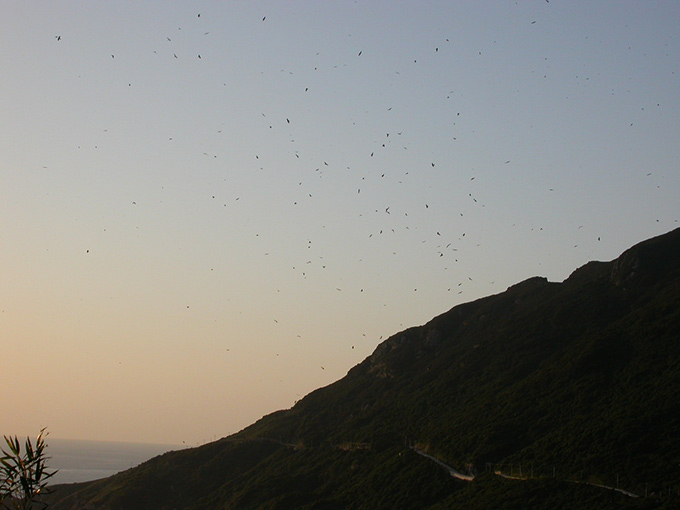
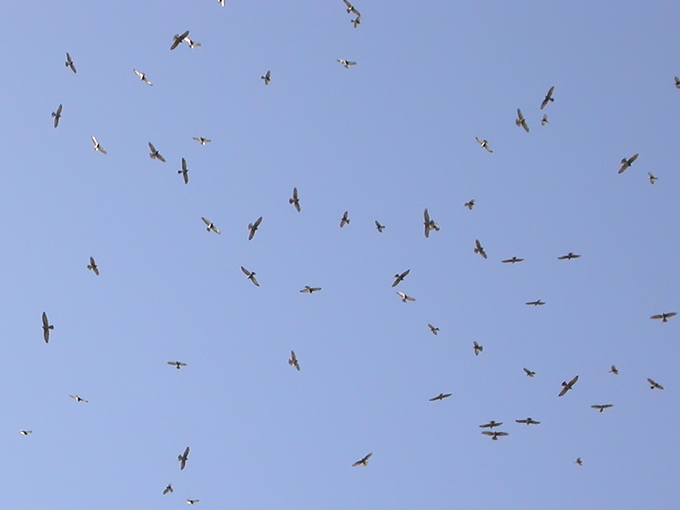
Socheong, October 2
A skulking Lanceolated Warbler (SKS only) started the days observations: stiffening winds through the morning did not deter a strong passage of raptors, which lasted until about 1pm. This involved some 60 Crested Honey Buzzard (allowing for an interisting comparison of color variants), 3 Black Kite, c.40 Northern Goshawk (mostly juveniles), 50 Japanese Sparrowhawk, 40+ Eurasian Sparrowhawk plentiful Northern Hobby, 5 Eastern Buzzard, 2 Amur Falcon (+4 more via KSH over at the radio mast).
Other migrants flowing anxiously overhead included c. 20 Olive-backed Pipit, up to 180 Red-rumped Swallow, and a single Greater Short-toed Lark (showing shorter tail than Northern.)
Also present, a restless flock of 15-20 Chestnut White-eye,nhundreds of Pelagic Shag offshore with a few Temminck's Cormorant mixed in. The resident Peregrine pair seem to be expending much energy harrassing passing smaller raptors, as well as apparently driving away their confused fully-grown fledgling: perhaps encouraging it to find its own territory elsewhere.

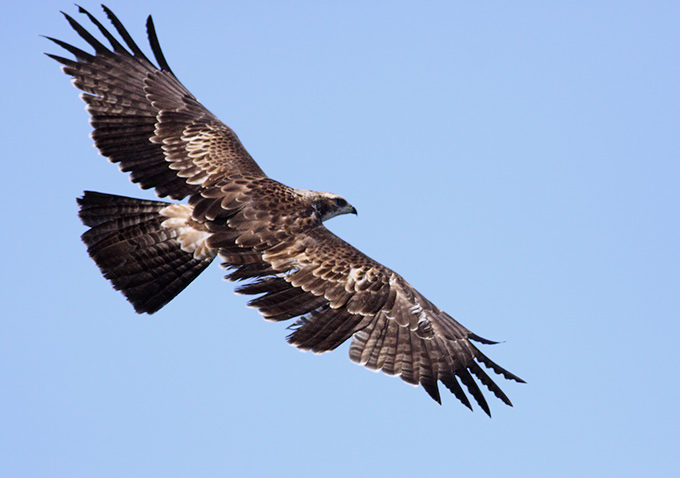



East Coast of Gangwon Province, October 2
I moved from Yanggu to Ganseong north of Sokcho at the end of August with my work. Secretly, I wanted to be closer to the coast so I can observe the migration of birds along the east coast of Korea. So far I haven't seen large numbers of birds, but there have been some interesting species here over the last month or so.
Around the end of August I saw Red-necked Stints in Yanggu and Far Eastern Curlews, Whimbrels, Wood Sandpipers, a Terek Sandpiper, Grey Plovers, Mongolian Plovers, Black-headed Gulls, an Osprey and Grey-spotted Flycatchers at Namdaecheon near Yangyang. Sanderlings and a Red-necked Stint were seen feeding on wave-washed rocks at Cheongganjeong on the last Saturday of the month.
A visit to Namdaecheon again on September 12 saw Bar-tailed Godwits, Grey Plovers, Greenshanks, a Ruddy Turnstone, Kentish Plovers, an Osprey, Common Teals and Yellow Wagtails. Namcheon at Ganseong has also had small numbers of migratory birds during September including Grey Plovers, Golden Plovers, Common Sandpipers, Green Sandpipers, a Dunlin and Common Snipe. In the last week there were Mallards, Common Teals, Wigeons, a Gadwall, a Pochard, 2 Northern Shovelers, a White-fronted Goose and a Bean Goose. Mallards and Common Teal have been present for most of September, as have Grey Plovers, Wood Sandpipers and Hobbies. Along Bukcheon north of Ganseong I saw Chestnut Buntings on the first weekend of September and a couple of weeks later there was a Grey-tailed Tattler, a Grey Plover, a Peregrine Falcon and Eurasian Hobbies. On September 28, I heard and saw 2 White-eyes fly over Ganseong Elementary School. And twice during the month I heard a Eurasian Eagle Owl calling from my apartment at night.
A visit to Namdaecheon on October 2 was initially a bit disappointing with few birds on the sandbar near the rivermouth. Although I was there early in the morning, birds had already been disturbed by recreational fishermen and other people walking through the area. Still, there were Black-tailed Gulls, Grey Herons, Great Cormorants and a Grey Plover there. I also found Spot-billed Ducks and Wigeons in a small dam behind the flood bank. Closer to Yangyang there were a few interesting birds. An Osprey was twice, both times carrying a fish, the second fish was much smaller than the first. Two White-fronted Geese, 12 Golden Plovers, 2 Greenshanks and 2 Green Sandpipers were seen as well. The most interesting birds were a Richard's Pipit and a Chinese Grey Shrike near the baseball diamonds. Close to the highway bridge near Yangyang there were Grey Herons, Eastern Great Egrets, Little Egrets, Great Cormorants and Spot-billed Ducks.
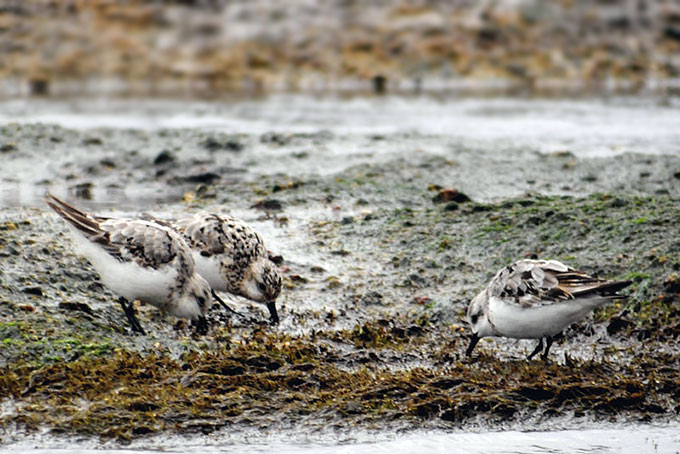

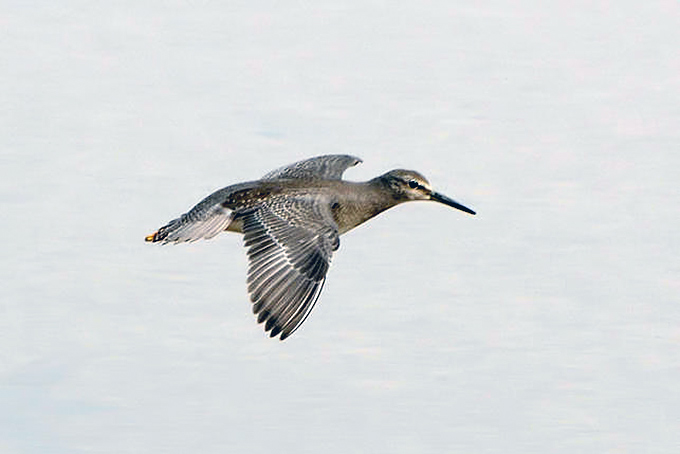





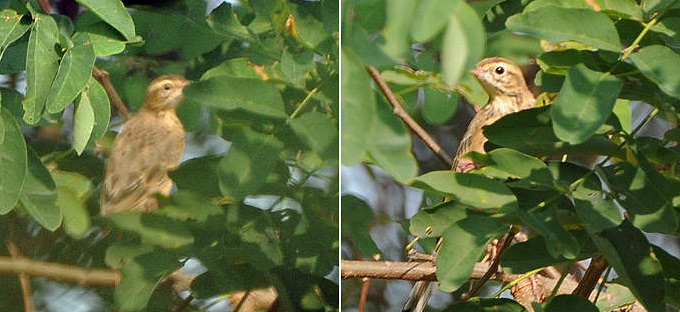
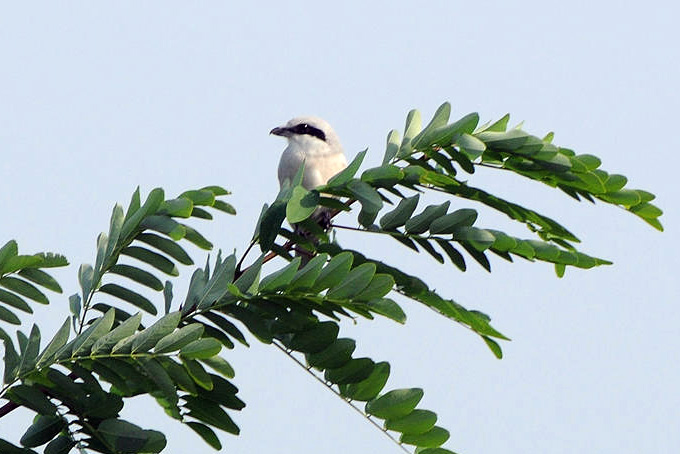
Incheon-Socheong, October 1
A calm crossing in warm and sunny conditions revealed among the 90+ Streaked Shearwater no less than 3 Flesh-footed Shearwater: they seem to prefer feeding along glassily flat patches of the sea, which are bizaarrely bordereded by contrastingly choppy waves. Also, 1 Dark form Parasitic Skua and 2 Pomarine Skua.Several Vega Gull were apparent among more numerous Mongolian Gull. Intriguing were brief views of a large alcid showing all dark head and thick bill (TE only)- perhaps a Brunnich's Guillemot as possibly seen in the same area on Sept 21st? Early signs of migration included a handful of Barn Swallow winging their way over the waves.
Afternoon on the island found 4 Korean Bush Warbler, 1 Siberian Stonechat, 1 Lanceolated Warbler, 1 Asian Brown Flycatcher, up to 10 Black-faced Bunting, a Grey-streaked Flycatcher, a scattering of Yellow-browed Warbler and 5 lugens White-Wagtail.There are 8 apparently resident Large-billed Crow, which roost and feed together.
Watching from the radio mast gave close views of c. 20 Pacific Swift, passing Eurasian & Japanese Sparrowhawks, Common Kestrels, bunches of Red-rumped Swallow and a handful of Oriental Honey Buzzard. Kim Sung Hyun, who has been conducting research into raptor migration here over the past 10 days, told of 2 juvenile Black Stork on Sept 29 & 30th, a recent Greater Spotted Eagle, and 1000+ Oriental Honey Buzzard in a single day last week.
Near 2nd village in the evening, we all were delighted at close views of an amiable Little Owl, which comically stood on tip-toes to gain a better stare at us, before hunching down into a ball and launching away.


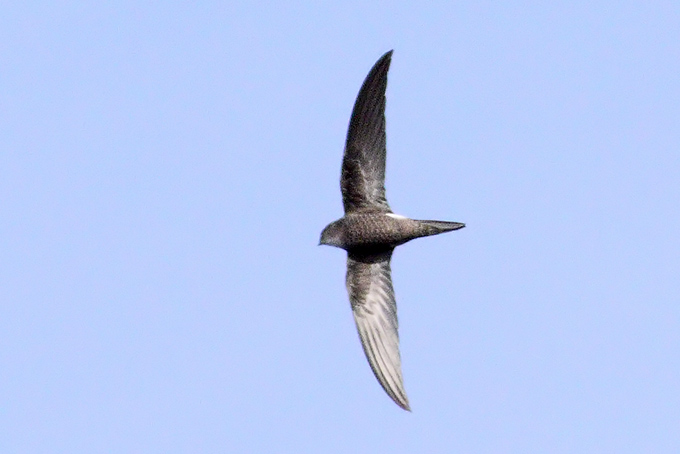
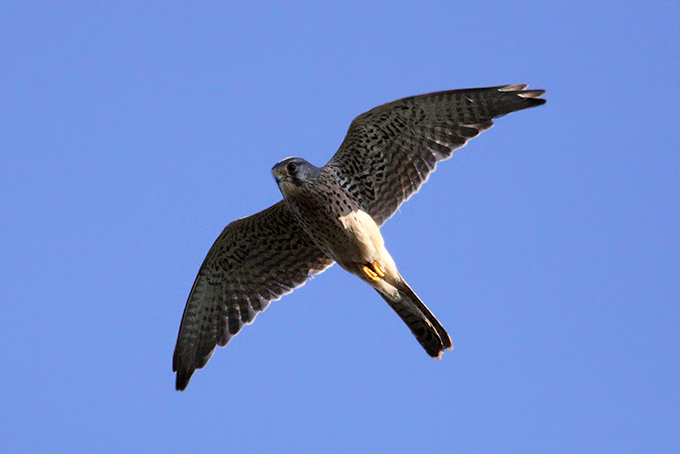

Gangneung, October 1
A day trip to the Namdaecheon (stream) area produced several Japanese Wagtails (the first walking around a gas station!) and Grey Wagtails, a dozen White-cheeked Starlings, 2 Ospreys, several Great Egrets, a few Common Greenshanks and Black-tailed Godwits, a single juvenile Curlew Sandpiper, one each of Whiskered and White-winged Terns along with 60 or so Black-headed Gulls, 2 Wigeon, 2 Tufted Duck, and the season’s first Eurasian Sparrowhawk. Highlight for me was my first ever Amur Leopard Cat.

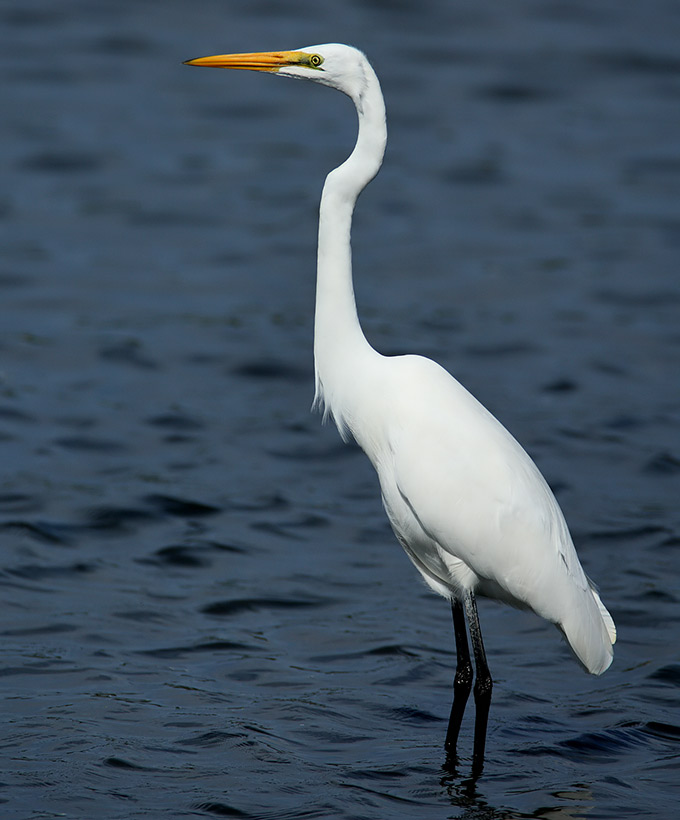



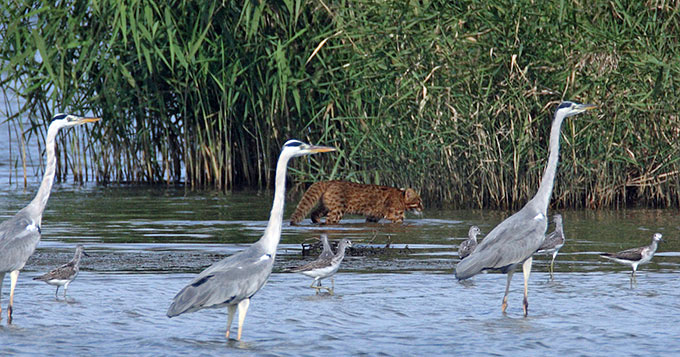
Gageo Island, October 1 (Morning update)
Ahead of another spell of forecast rain, a circuit of 1-Gu found that many birds had either departed overnight or become less visible, with only 29 species logged, and almost no species present in double figures. Species of most note included the Red-backed Shrike and yesterday’s Blyth’s Pipit still, and decent views of 3 or more Far Eastern Cisticola, all appearing paler than those seen on Socheong a week or so earlier.

